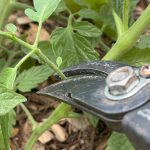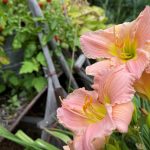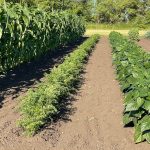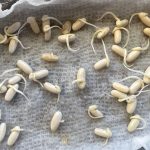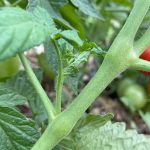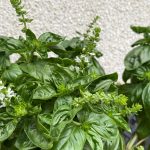Strawberries are one of the most popular fruits in North America. We often grow strawberries in the ground here in Alberta and now new everbearing cultivars allow us to grow them all through our summer season in stand alone planters and in hanging baskets.
In this blog we will discuss:
- Interesting facts about strawberries
- Where to grow strawberries in planters
- Components of a successful strawberry planter
- How to care for strawberry planters and hanging baskets
Interesting Facts About Strawberries
What plant family are strawberries in?
Did you know that from a botanical perspective, strawberries are not considered to be berries? Strawberries are a multiple fruit, with each seed surrounded by flesh being individual fruits. Each berry carries up to 200 seeds.
Strawberries are a member of the rose family (isn’t that an interesting surprise?), they are high in Vitamin C, and great for preventing scurvy and multiple other ailments.
Where are strawberries native to?
Strawberries are native to the continents of North & South America, Europe, Asia, and the Arctic; leaving out Africa, Antarctica, Australia and New Zealand. Interest in growing strawberries dates back to the 1300s where they were first cultivated from the wild in Europe in the 14th century.
A lot of research and cross breeding ensued in France and England at that time, and all modern strawberries that we currently enjoy can trace their lineage to strawberries originating in Chile and the state of Virginia in the United States. The goal was to develop a big, hardy, and tasty strawberry. And I think this was accomplished.
Where are strawberries produced?
The stats show that we in North America love strawberries. California grows 1 billion pounds of strawberries annually and Florida comes in second with over 220 million pounds. California generally produces the summer berries we enjoy and Florida grows most of the winter crop of strawberries available to the North American market. Florida’s sandy soil makes it perfect for growing strawberries.
No matter where strawberries are grown, weather can influence the flavour of a strawberry. If the weather is cold and rainy, strawberries tend to taste bland. If they are grown in warm temperatures with the right amount of rain, they are tasty and wonderfully succulent.
Where is the Best Place to Grow Strawberries in Planters?
Not everyone has ground to till. Growing strawberries in hanging baskets and containers works well for anyone, actually. They are ideal for people who have limited growing spaces on porches, balconies, and tiny yards.
Strawberries are a cool weather crop. Their favourite temperature range is from 15-26C (60-80F) to 26C. They can go as low as -5C (23F), but I wouldn’t recommend letting your hanging baskets or planters get this cold because of the stress it could cause to the plants. It’s a good idea to bring them indoors when the overnight forecast is 8-10C (46-50F).
For inground strawberries, cover them with old sheets or tarps. Avoid using plastic for a protective cover, because plastic tends to draw in the cold.
Strawberry plants are sun lovers. Strawberries grown in hanging baskets and planters need to get a minimum of 6-8 hours of direct sunshine daily, and more is even better. So before placing a strawberry planter or hanging basket in your space, be sure to check how much sunshine your location gets.
You can find this kind of sun exposure on the east, south, and west facing sides of a building. Take note of shade casting elements like other buildings, trees, and overhanging eaves. Also check to see that your location has good air circulation. On a balcony, that would look like railings that have spaces between them. Areas with little air movement can cause strawberries to get moldy.
The beauty of planters and hanging baskets is that if the space you’ve chosen isn’t right and isn’t working for your strawberries, you can just pick it up and move it!
Components of Successful Strawberry Planter
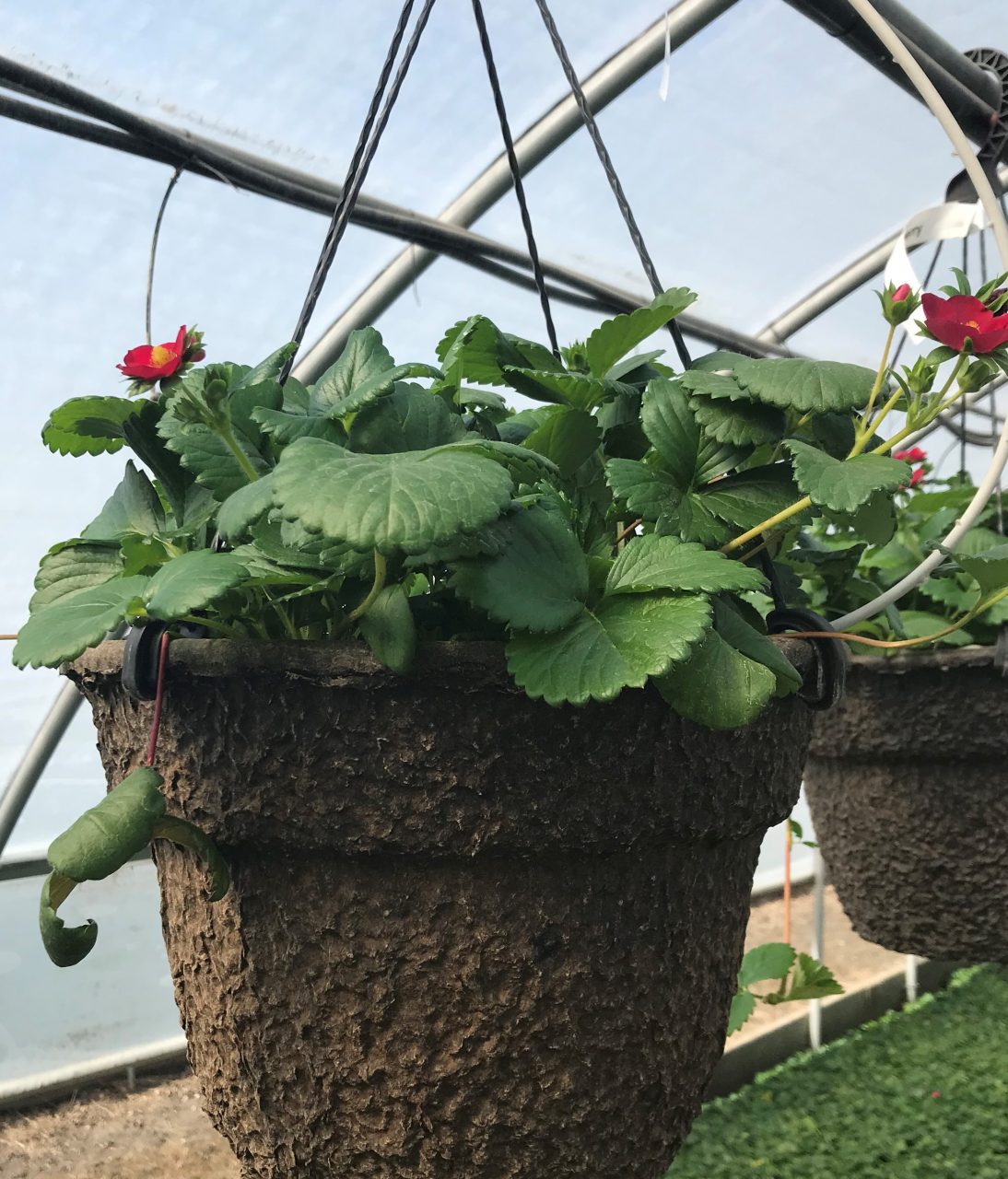
What do you need for a strawberry planter to flourish?
It doesn’t take a lot to make a great and successful strawberry planter, the following list outlines the really important ones:
1. Make sure that the container you have chosen for your strawberry planter has drainage holes.
This is very important because strawberries hate to have wet, soggy feet. Strawberry roots will rot if the soil holds on to the water.
Deck and porch staining is often a concern for people growing plants on decks. Rather than compromising drainage by using a pot that has no holes, find a nice decorative and functional drip plate to put underneath the strawberry pot.
2. Strawberries need high quality soil with good water retention and good drainage capability.
Good soil has plenty of air spaces to hold water, yet allows those spaces to drain excess water. My favourite kind of soil is one that has composted bark. These types of good quality soil are often found at greenhouses and garden centers.
3. Plant your strawberries in the right sized planter.
Strawberries have shallow root systems and don’t need really deep pots to grow well and a pot that is 20 cm (8″) deep is completely sufficient for them.
How wide a container to use for strawberries is another question and that depends on how many strawberry plants you would like to plant together. In a pot with a top diameter of 30 cm (12″) you can easily place 3-4 strawberries with enough room for them to grow comfortably. I wouldn’t put more than 4 in there and would probably go for 3.
If you would like to plant more strawberries, then you should upsize the pot accordingly. Remember that as the pot sizes and diameters increase, so too do their depth. I feel that the ideal pot for a strawberry hanging basket is 30 cm (12″) across and 20-30 cm (8-12″) deep. Instead of growing one crazy big pot for strawberries, I would rather do more 30 cm (12″) pots so that the drainage can be maintained better.
4. Find a strawberry variety suited for a hanging basket or container.
Day neutral strawberry varieties are best for planters and hanging baskets because they bear all season long. The berries are smaller than June bearing strawberry plants and the day neutral varieties are more compact.
How to Care for Strawberry Containers (H2)
Daily care of any plant is key to their success. Let’s use my plant TENDing system where I use the word TEND to outline 4 steps to care for your strawberry container or hanging basket.
T – Take a Good Look at Your Strawberry Planter Everyday
Give your strawberry container or hanging basket a quick daily head-to-toe assessment.
Check for things like:
- Leaf Colour – Leaf colour is the first indication of plant health.
- Is the colour a deep dark green? Are there yellow, spotted, black, or moldy leaves?
- When you see something other than a healthy green leaf, look a little deeper. Is the leaf just old? If so, remove it. Is there mold? Remove that one and take off some other leaves all over the plant to improve air circulation in and around the plant.
- Check for bugs – quickly turn over a few leaves to see if you have any pests living on your plant. They love to hide on the bottom sides of leaves or on the top of the soil because they are safe there.
E – Ensure that Your Strawberry Planter has Ample Water
Checking that there is enough water available to your strawberry planter is also a daily practice.
There are a couple of ways to check for adequate hydration:
- If your strawberry container is light enough to pick up, check the weight. Get familiar with what the weight is when it is completely saturated after you have watered it and then keep monitoring it as the days pass. When it gets light and before the plants have wilted, water it so the water drips out of the bottom of the pot.
- If your container is too heavy to pick up, then poke your index finger in the soil to the second knuckle. If it is dry at the tip of your finger, it is time to water. If the planter is shallow, like 30 cm (12″) it is okay to have the water drip out of the bottom. However, as pots get larger and deeper, allowing water to flow out of the bottom could actually result in an overhydrated container, so be careful to monitor your plants.
- Bear in mind that most strawberry roots live in the top 8-10 cm (3-4”) of the soil. Keep your strawberry well drained, and not wet. Strawberry roots have a low tolerance for being soggy and they will rot.
N – Nutrition
This step is about fertilizing. Knowing how to fertilize plants growing containers is an important step because containers have a finite amount of soil. Water often drips out of the bottom of planters and the water takes fertilizer with it where the nutrients get washed out of the soil.
Fertilize strawberry containers weekly with a balanced fertilizer like 20-20-20 or any other fertilizer that is suited for strawberries. You may prefer an organic or natural fertilizer. Follow package instructions as directed.
D – Deadhead and Boost Growth
This step is about keeping your strawberry plants trimmed back and tidy to maintain their health and productivity.
- Pick ripe strawberries when they are ready to promote new flowering and more berry growth.
- If the strawberry plant gets straggly, just trim it back by pinching it or clipping it back with a pair of scissors. It is always best to trim near the leaf nodes – that’s the area where leaves emerge from the stems.
Will strawberries survive in containers in Alberta to regrow the next spring if they stand outside over the winter?
The short answer is no, and here is why:
- Strawberries are a tender crop for our Edmonton area climate at best.
- Most strawberries have a zone 4 or higher hardiness rating, and there are few varieties that are a zone 3. Even zone 3 strawberries planted in the ground need to be mulched to winter over successfully. The surrounding ground is important for insulating strawberry roots and the added mulch helps protect the crowns of the plants through our winters.
- In a container, strawberry plants don’t have the surrounding ground to help insulate their roots. Think of their roots as being in an ice cube tray – when the circulating air gets really cold, the roots and crowns freeze and die. This is the reason that most plant material like strawberries or even trees aren’t able to survive the winter in a stand alone container.
Summing Up Strawberry Hanging Baskets and Containers
With the new day neutral strawberry varieties available, a continual supply of strawberries grown in a container is possible. By selecting the right sunny location and caring for them consistently, your strawberries will grow, thrive and bear fruit all summer long!
© Sharon Wallish Murphy, Gardening with Sharon




